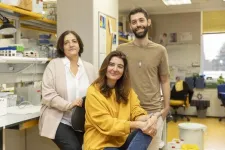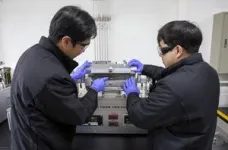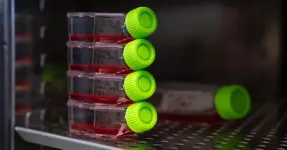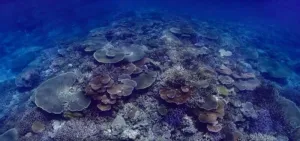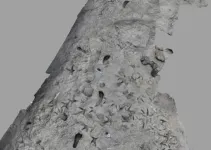(Press-News.org) Ewing sarcoma is a tumour of the bones and soft tissues that occurs in children and young people. A quarter of patients do not respond well to therapy.
The group led by Ana Losada, at Spain’s National Cancer Research Centre (CNIO), has discovered an alteration in the most aggressive cases that affects genes never previously related to this disease.
This finding expands the list of potential prognostic markers and therapeutic targets in the most aggressive cases of Ewing sarcoma.
The new research is published in EMBO Reports.
Ewing sarcoma is a tumour of the bones and soft tissues that occurs in children and young people. Like all childhood cancers, it is rare – 9 to 10 cases per million inhabitants per year – but it is very aggressive. 25% of patients do not respond well to regular therapy and they often experience relapses.
A new study led by Ana Losada, head of the Chromosomal Dynamics Group at Spain’s National Cancer Research Centre (CNIO), identifies several mechanisms that increase the aggressiveness of Ewing sarcoma, promoting metastasis and leading to a poorer prognosis.
This finding opens up new avenues for seeking treatments, since it “provides a list of potential [prognosis] biomarkers and therapeutic targets,” the authors write in EMBO Reports. Ana Cuadrado is co-corresponding author of the study and Daniel Giménez-Llorente is the first author.
Ewing sarcoma is caused by the abnormal fusion of two genes, which results in an oncogene. The protein produced by this oncogene causes the expression of genes that promote tumour development. It was already known that the absence of a protein known as STAG2 amplifies the harmful effect of this oncogene, but the new study now shows that there are also alterations in the expression of many other genes.
Ana Cuadrado, corresponding author of the study, explains that the absence of the STAG2 protein "also modifies the expression of other genes that do not depend on the oncogene, and these changes also increase tumour aggressiveness".
A key protein for life
STAG2 is part of a complex of proteins essential for life, cohesin, discovered in vertebrates by Losada in the late 90s. Cohesin is key in cell division and during the process of reading genes –their expression–.
When the cell divides, it duplicates its chromosomes so that each of the daughter cells gets a copy of the DNA; during that duplication, the chromosomes are arranged in an X, and cohesin is the ring that binds them together at the centre (hence its name).
The rest of the time, when the cell is not dividing, cohesin generates bonds that help the DNA to fold and acquire the appropriate spatial arrangement, which is important for the information of the genes to be correctly read (all cells have the same genes, and their differences – some of them will build skin, some others eyes, or muscl...–are due to the fact that each cell type reads or expresses different genes according to their function).
Errors in the reading of genes
The paper published in EMBO Reports shows that when cohesin STAG2 is missing, DNA folds incorrectly, causing failures in the expression of many genes.
“The cohesin that carries STAG2 moves along the DNA forming bonds that facilitate physical contact between elements that control the reading of many genes; if it disappears, gene expression becomes more difficult,” says Losada. “The cells survive, but with many aberrations that turn them more aggressive.”
Influence on the immune response
The importance of identifying more genes – independent of the oncogene– affected by the absence of STAG2 “is that it opens the door to investigate how each of them contributes to the aggressiveness of tumours,” explains Losada.
For example, future studies comparing the immune response of patients with and without STAG2 mutations may help us understand whether tumours without STAG2 are better able to elude the immune system. This knowledge would be very useful when applying immunotherapy for Ewing sarcoma.
In addition to altering gene expression, the loss of STAG2 could affect the stability of the genome itself, as this is another function of the cohesin complex. That is, there could be several mechanisms affected by the loss of STAG2, and those that contribute in turn to the poorer prognosis of the disease. We need to shed light on each of these mechanisms, “in order to provide novel treatment options for cohesin-mutant patients,” the study says.
This research has been funded by the Spanish Cancer Association (AECC) and the Spanish Research Agency (AEI).
END
CNIO opens up new research pathways against paediatric cancer Ewing sarcoma by discovering mechanisms that make it more aggressive
2024-11-29
ELSE PRESS RELEASES FROM THIS DATE:
Disease severity staging system for NOTCH3-associated small vessel disease, including CADASIL
2024-11-29
About The Study: The findings of this study suggest the NOTCH3-associated small vessel disease (NOTCH3-SVD) staging system will help to better harmonize NOTCH3-SVD and cerebral autosomal dominant arteriopathy with subcortical infarcts and leukoencephalopathy (CADASIL) cohort studies and registries; may improve individualized disease counseling, monitoring, and clinical management; and may facilitate patient stratification in clinical trials.
Corresponding Authors: To contact the corresponding ...
Satellite evidence bolsters case that climate change caused mass elephant die-off
2024-11-29
A new study led by King’s College London has provided further evidence that the deaths of 350 African elephants in Botswana during 2020 were the result of drinking from water holes where toxic algae populations had exploded due to climate change.
The lead author of the report says their analysis shows animals were very likely poisoned by watering holes where toxic blooms of blue-green algae, or cyanobacteria, had developed after a very wet year followed a very dry one.
Davide Lomeo, a PhD student in the Department of Geography at King’s College London and co-supervised by Plymouth Marine Laboratory (PML) and ...
Unique killer whale pod may have acquired special skills to hunt the world’s largest fish
2024-11-29
Killer whales can feed on marine mammals, turtles, and fish. In the Gulf of California, a pod might have picked up new skills that help them hunt whale sharks – the world’s largest fish, growing up to 18 meters long.
Whale sharks feed at aggregation sites in the Gulf of California, sometimes while they are still young and smaller. During this life-stage, they are more vulnerable to predation, and anecdotal evidence suggests orcas could be hunting them. Now, researchers in Mexico have reported four separate hunting events.
“We show how orcas displayed a collaboratively hunting technique on whale sharks, characterized by ...
Emory-led Lancet review highlights racial disparities in sudden cardiac arrest and death among athletes
2024-11-29
UNDER STRICT EMBARGO UNTIL 6:30 PM November 28, 2024:
A recent major review of data published by the Lancet and led by Emory sports cardiologist Jonathan Kim, MD, shows that Black athletes are approximately five times more likely to experience sudden cardiac arrest (SCA) and sudden cardiac death (SCD) compared to White athletes, despite some evidence of a decline in rates of SCD overall. SCA and SCD have historically been a leading cause of mortality among athletes, particularly those involved in high-intensity sports.
The disparities in SCA/D rates highlights the need for increased research into the social determinants of health in younger athletes, a topic that remains ...
A new approach to predicting malaria drug resistance
2024-11-28
Researchers at University of California San Diego analyzed the genomes of hundreds of malaria parasites to determine which genetic variants are most likely to confer drug resistance. The findings, published in Science, could help scientists use machine learning to predict antimalarial drug resistance and more effectively prioritize the most promising experimental treatments for further development. The approach could also help predict treatment resistance in other infectious diseases, and even cancer.
“A lot of drug resistance research can only look at one chemical agent at a time, but what we’ve been able to do here is create a roadmap ...
Coral adaptation unlikely to keep pace with global warming
2024-11-28
Coral adaptation to ocean warming and marine heatwaves will likely be overwhelmed without rapid reductions of global greenhouse gas emissions, according to an international team of scientists.
Their study, led by Dr. Liam Lachs of Newcastle University, reveals that coral heat tolerance adaptation via natural selection could keep pace with ocean warming, but only if Paris Agreement commitments are realised, limiting global warming to two degrees Celsius.
“The reality is that marine heatwaves are triggering mass coral bleaching mortality events across the world’s shallow tropical reef ecosystems, and the increasing frequency and intensity of these events ...
Bioinspired droplet-based systems herald a new era in biocompatible devices
2024-11-28
UNDER EMBARGO UNTIL 19:00 GMT / 14:00 ET THURSDAY 28 NOVEMBER 2024
Bioinspired droplet-based systems herald a new era in biocompatible devices
Oxford University researchers have developed a set of biocompatible devices, which can replicate or surpass many electronic functions but use ions as the signal carriers.
The ‘dropletronic devices’ are made from miniature soft hydrogel droplets and can be combined to produce diodes, transistors, reconfigurable logic gates, and memory storage devices that mimic biological synapses.
The research team generated a biocompatible, dropletronic ...
A fossil first: Scientists find 1.5-million-year-old footprints of two different species of human ancestors at same spot
2024-11-28
More than a million years ago, on a hot savannah teeming with wildlife near the shore of what would someday become Lake Turkana in Kenya, two completely different species of hominins may have passed each other as they scavenged for food.
Scientists know this because they have examined 1.5-million-year-old fossils they unearthed and have concluded they represent the first example of two sets of hominin footprints made about the same time on an ancient lake shore. The discovery will provide more insight into human evolution and how species cooperated and competed with ...
The key to “climate smart” agriculture might be through its value chain
2024-11-28
In 2023, the United Nations climate conference (COP28) officially recognized the importance of agriculture in influencing and mitigating climate change. In a Policy Forum, Johan Swinnen and colleagues offer an approach to overcome challenges related to improving climate-sensitive farming practices across the globe. They discuss the importance of working with Agricultural Value Chains (AVC) by incentivizing small businesses who play an important role in the support of small- and medium-sized farms. This would involve both upstream enterprises related to seeds, fertilizer, ...
These hibernating squirrels could use a drink—but don’t feel the thirst
2024-11-28
The thirteen-lined ground squirrel doesn’t drink during its winter hibernation, even though systems throughout its body are crying out for water. Madeleine Junkins and colleagues now show that the squirrel suppresses the need to quench its thirst by reducing the activity of a set of neurons in highly vascularized brain structures called circumventricular organs, which act as a specialized connection point between brain, blood circulation and cerebrospinal fluid. The study by Junkins et al. helps explain how some hibernating animals ignore the powerful physiological drive to seek out water ...
